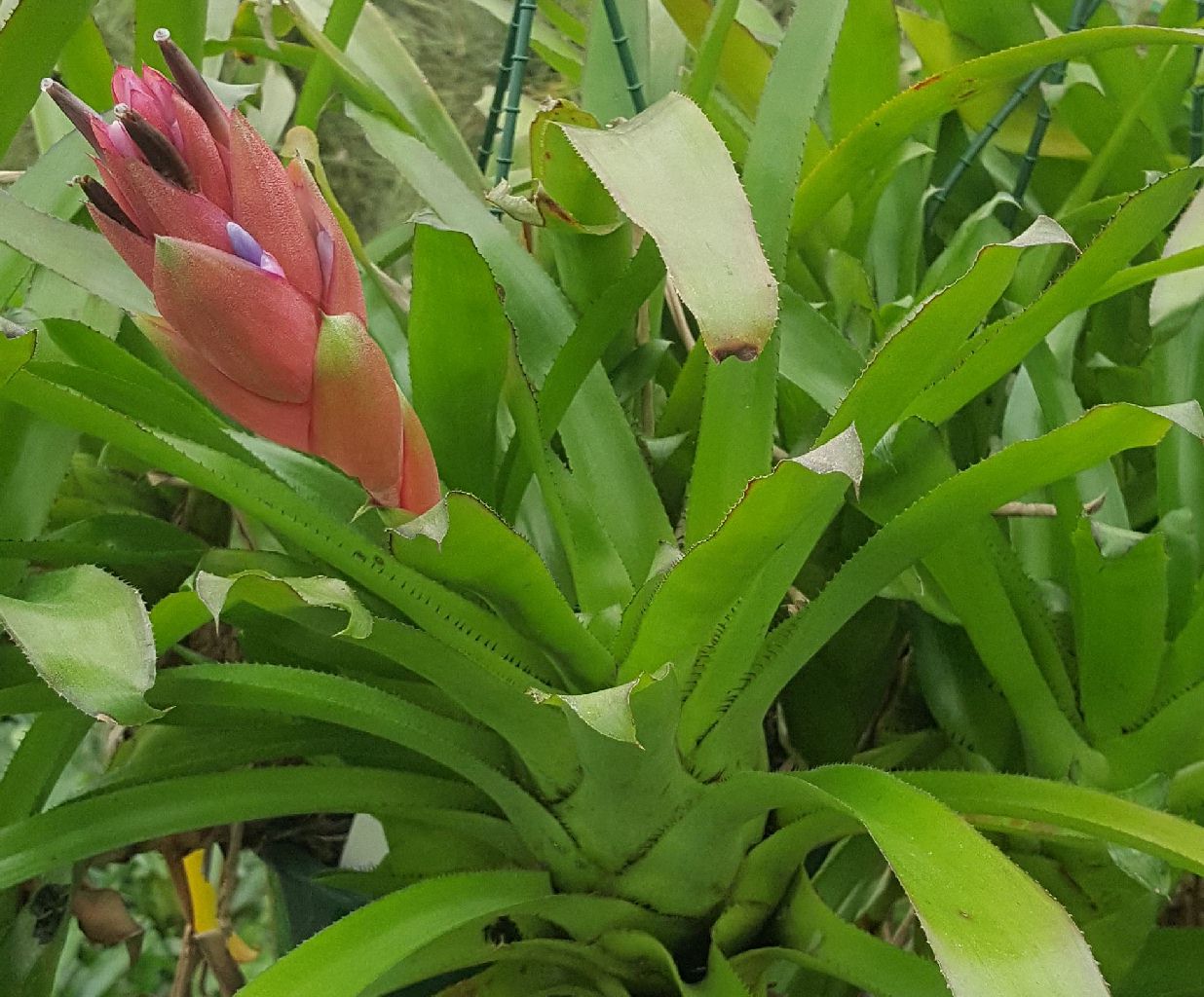
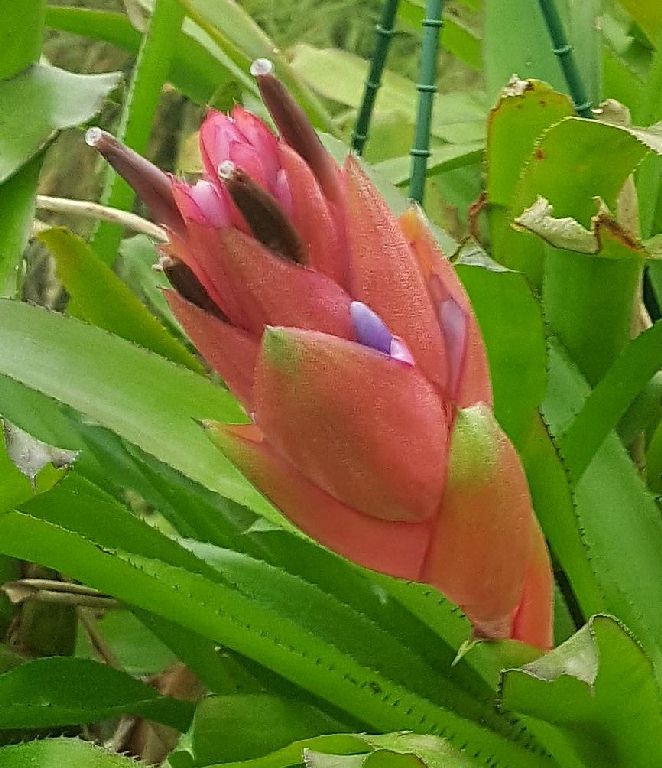
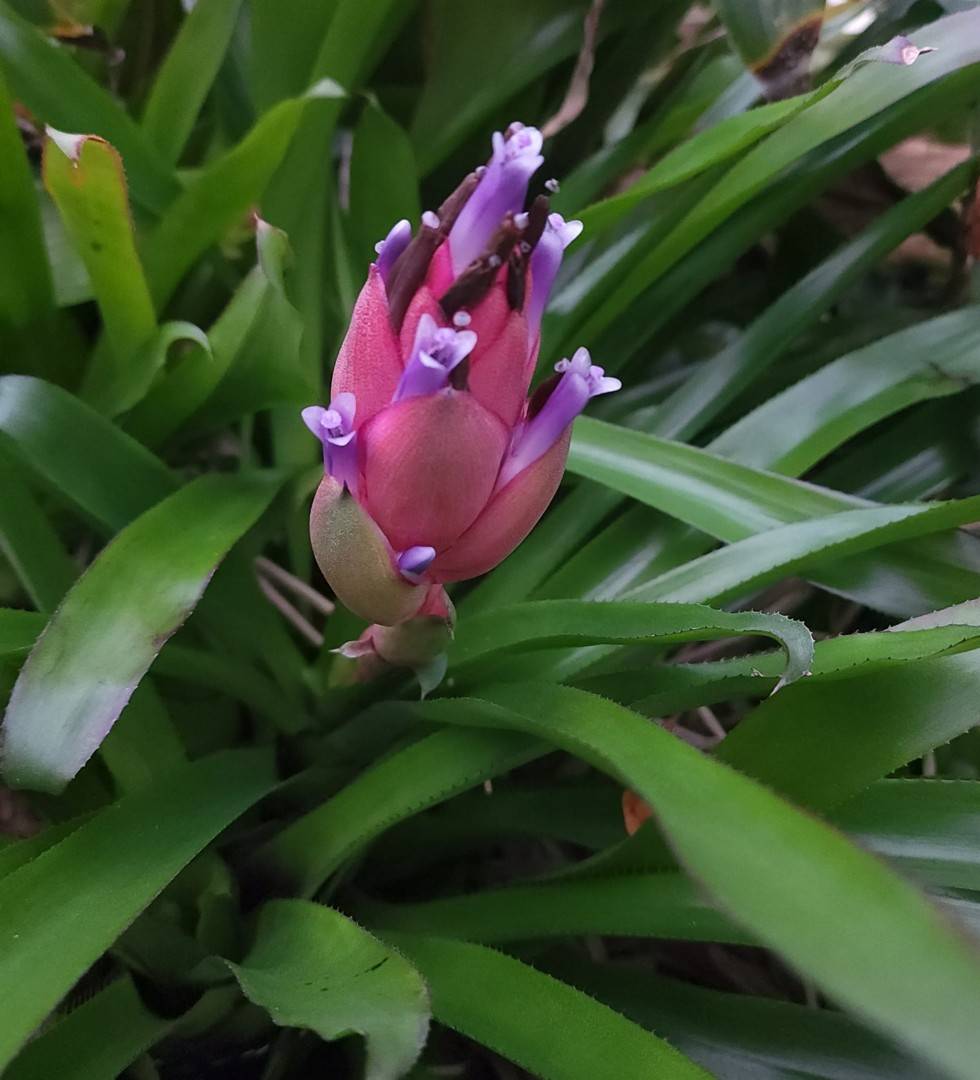
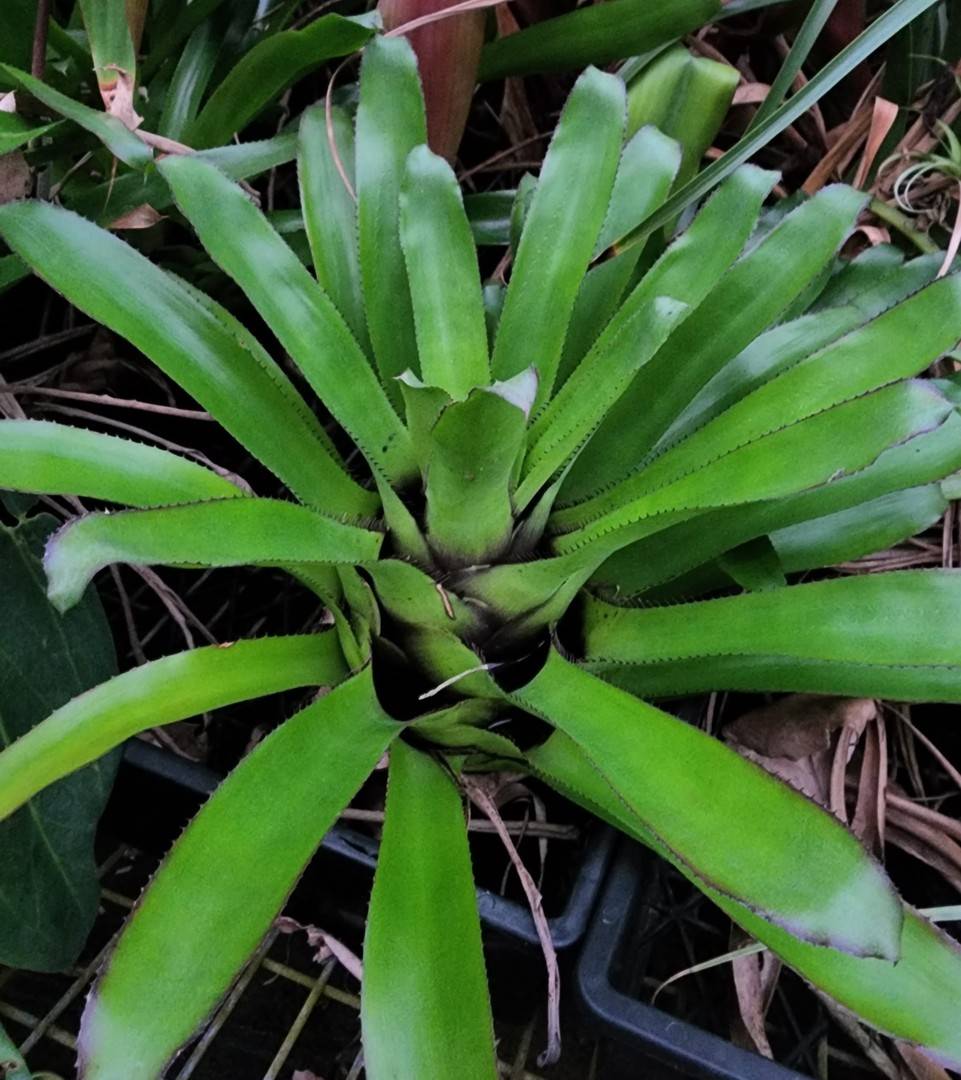
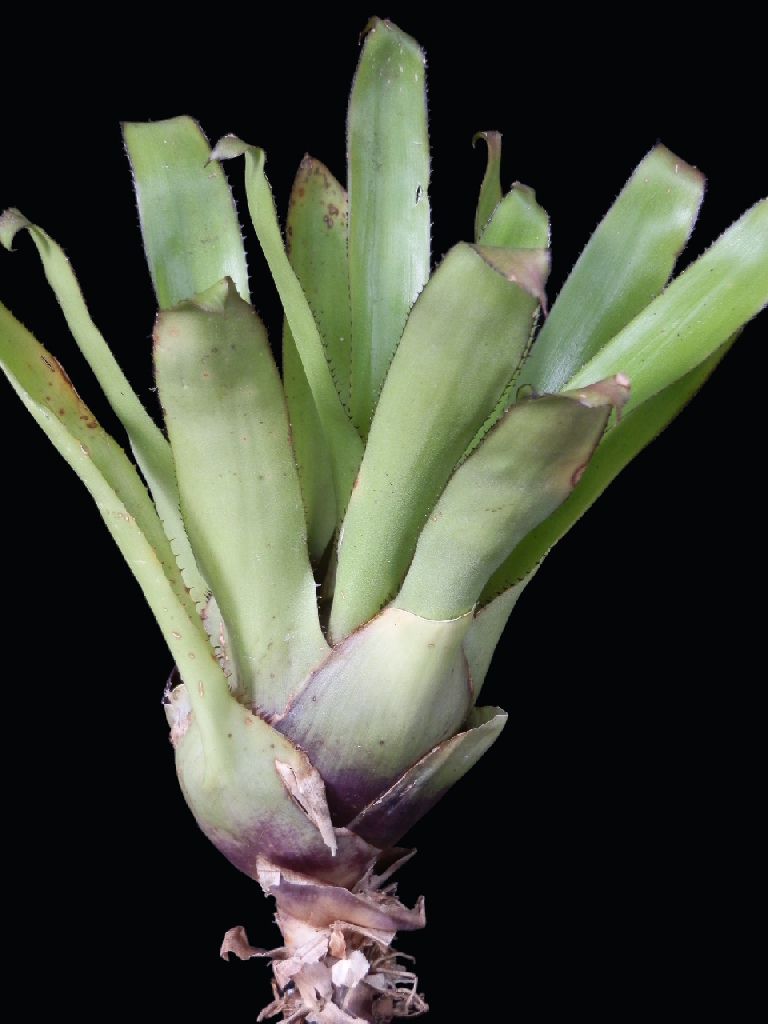



A Portea kermesina Brongniart ex K. Koch, cui affinis, planta solum ca. 30 cm alta, laminis foliorum distincte brevioribus et angustioribus, basin versus haud angustatis, inflorescentia 6-8 cm longa, ca. 3 cm diam., bracteis primariis ramos omnino occultantibus et solum petala per anthesin exhibentes, ramis basalibus ca. bifloris, bracteis floriferis ramulorum subellipticis vel sublinearo-lanceolatis, 20-30 x 5-10 mm, floribus minoribus et sepalis brevioribus subduplo angustioribus differt.
Plant epiphytic, stoloniferous, stolons ca. 14 cm long, ca. 1 cm in diameter, flowering ca. 30 cm tall.
Leaves 20 to 30 in number, suberect, densely rosulate, forming a broad subglobose water reservoir at base;
Sheaths broadly elliptic, 8-9 x 6-7 cm, minutely pale-lepidote, dark purple;
Blades linear, apex acute and slenderly apiculate, not narrowed toward the base, 10-16 x 2.7 -3.3 cm, inconspicuously and sparsely lepidote on both sides, green, densely spinose, the basal spines acicular, straight to slightly retrorse, dark brown, 2-3 cm long, 2-3 cm apart, the apical spines paler, 0.5-1 cm long;
Scape 10-13 cm long, ca. 0.6 cm in diameter, subdensely white lepidote, whitish;
Scape bracts broadly elliptic, apex acute and slenderly apiculate, ca. 4.5 x 3 cm, minutely white lepidote, erect, imbricate and wholly covering the scape, reddish-pink, the upper ones inflated, margins wine colored, the basal ones spinulose toward apex, the upper ones entire.
Inflorescence corymbose, densely ellipsoid or nearly so, bipinnate at base, simple toward the apex, 6-8 cm long, ca. 3 cm in diameter, shorter to equaling the leaves;
Primary bracts resembling the upper scape bracts, densely imbricate and completely covering the branches (except for the exserted corolla at anthesis), erect, subinflated, reddish-pink, entire, apex acute to subrounded and minutely apiculate;
Branches 3 to 4 in number, ca. 5 cm long (including the petals), very shortly pedunculate, subdensely arranged, ca. 2-flowered;
Floral bracts those of the simple part of the inflorescence resembling the primary bract but smaller, elliptic-lanceolate, acute and minutely apiculate, 35-40 x 15-23 mm, entire, sparsely white lepidote, ecarinate, equaling to exceeding the sepals, erect, reddish-pink, those from the branches subelliptic to sublinear-lanceolate, acute and distinctly apiculate, apex suberect-recurved, 17-30 x 4-10 mm, equaling to exceeding the ovary, but usually distinctly shorter than the sepals, reddish-pink, glabrescent, obtusely carinate.
Flowers 45-47 mm long, erect, densely arranged, odorless, those from the simple part of the inflorescense polystichous, those from the branches nearly distichous, pedicels stout and not notably contrasting with the ovary, 3-5 mm long, ca. 3 mm in diameter, subdensely white-lanate;
Sepals strongly asymmetrical with a very broad lateral, rounded, membranaceous wing, mucronate, 11-18 mm long, including the apical suberect spine 2-3 mm long, ca. 7 mm wide near the apex including the lateral wing, connate at base for 7-9 mm, pink, sparsely white floccose near the base;
Petals sublinear, apex narrowly rounded, suberect at anthesis, 30-35 x 5 mm, free, lilac toward the apex, whitish near the base, bearing 2 suboblong to obovate, 2-3 mm long, apically truncate and minutely denticulate appendages at base, as well as 2 lateral callosities 18-22 mm long;
Filaments lilac-white, the antepetalous ones adnate to the petals for 17-22 mm, the antesepalous ones free; anthers 5-6 mm long, obtuse; stigma conduplicate-spiral, capitate-globose, lilac, margins entire or nearly so;
Ovary sub cylindrical, ca. 10 mm long, ca. 5 mm in diameter, whitish-rose, white -lanate; epigynous tube 2-2.5 mm long; placentation apical; ovules caudate.
Fruits unknown.
PARATYPES: Same locality as type, 7 Apr. 1995, E. Leme, P. Nahoum, A. Amorim, L.A. Mattos & J C. da Silva 3044, fl. cult. May 2001 (HB); Santa Luzia to Una, Serra da Onca, ca, 4.5 km from the road, 23 Jul. 1996, J G. Jardim, S.C. de Sant’Ana, H.S. Brito, J A.L. dos Santos & S. Oliveira 843 (CEPEC, NY).
Portea nana comes from a mountainous region covered by moist Atlantic forest at an altitudinal range of 500 to 600 m. The area is subject to dense fog, which provides ideal conditions for many epiphytes. This forest is rich in bromeliads, both epiphytic and terrestrial. Bromeliad taxa not previously recorded for the state of Bahia such as Neoregelia pauciflora, the wine-colored Nidularium innocentii, Vriesea flammea, and V. breviscapa were seen here.
The region contains many organisms still unknown to science, perhaps because it is hard to reach, or because the efforts of scientists have been concentrated in the lowland forests-always the first to be destroyed by human activities.
Portea nana grows on the higher branches of the tallest trees of the forest, some to 30 meters. With a long stoloniferous habit and a compact leaf rosette, P. nana forms dense clumps appearing very similar, from a distance, to those of some Neoregelia species.
Portea nana is closely related to P. kermesina, from which it differs in its long stoloniferous habit, the distinctly smaller size, only ca. 30 cm high, leaves shorter (20-30 cm vs. 40-80 cm), leaf blades narrower (2.7-3.3 cm vs. 4-5.5 cm) and not narrowed toward base, inflorescence smaller (6-8 x 3 cm vs. 10-20 x 5-8 cm), primary bracts completely hiding the branches, except for the exserted corollas at anthesis {not showing the sepals as in P. kermesina; see pictures in Rauh (1990) and Baensch and Baensch (1994)}, basal branches ca. 2-flowered (vs. 4 to 5-flowered), floral bracts of the branches subelliptic or sublinear-lanceolate, ca. 5-10 mm wide (vs. 15-20 mm wide), as well as by its shorter flowers (45-47 mm vs. 55-65 mm) and smaller sepals (11-18 x 7 mm vs. ca. 22 x 14 mm), bearing a much reduced lateral wing. In addition, the foliage rosette of P. kermesina tends to be more spreading with reddish tinged leaves.
The type of Portea kermesina was supposed to be deposited in the herbarium of the Botanischer Garten und Botanisches Museum, Berlin Dahlem, Germany (B). However, according to the information of the Curator of that institution, Dr. Manfred Baessler (pers. comm.), the type of P. kermesina is no longer extant. Smith and Downs (1979) cited the existence of probable clonotypes deposited in the National Museum of Natural History in Paris, France (P) and in The Netherlands National Herbarium, in Leiden (L). Although the material deposited in Paris herbarium was not examined for this study, all material deposited in Leiden herbarium looks very typical and probably represents clonotypes of P. kermesina. Examined material of P. kermesina used for comparison in this study are as follows: Brazil: without locality, Leiden Hortus 3640,21 Dec.1964 (L); Leiden Hortus 8291, 10 Apr. 1969 (L); Leiden Hortus 8291A, 7 Feb. 1970 (L); Leiden Hortus 8281, 13 May 1976 (L); Leiden Hortus, leg. B.K. Boom s.n., 27 Feb. 1953 (L); leg. B.K. Boom s.n., 9 Aug. 1955 (L); ex hort. R. Burle Marx s.n., fl. cult. E. Leme 3296, Aug. 2001 (HB); ex. hort Wally Berg 94, fl. cult. E. Leme 4662, Aug. 1999 (HB).